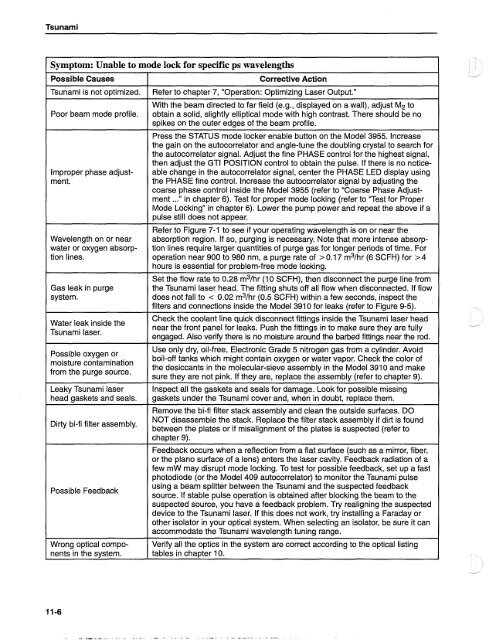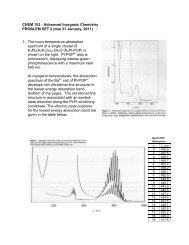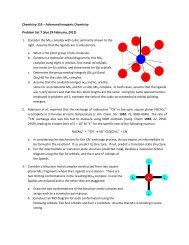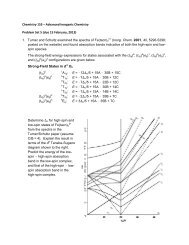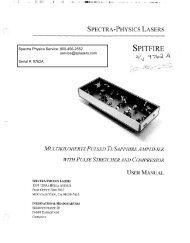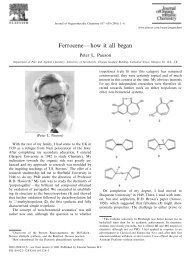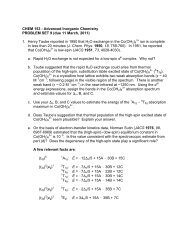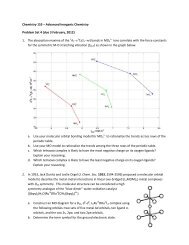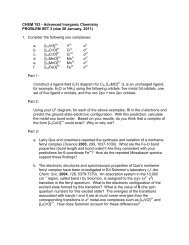Tsunami - Beckman Institute Laser Resource Center
Tsunami - Beckman Institute Laser Resource Center
Tsunami - Beckman Institute Laser Resource Center
Create successful ePaper yourself
Turn your PDF publications into a flip-book with our unique Google optimized e-Paper software.
<strong>Tsunami</strong><br />
Symptom: Unable to mode lock for specific ps wavelengths<br />
Possible Causes<br />
<strong>Tsunami</strong> is not optimized.<br />
Poor beam mode profile.<br />
Improper phase adjustment.<br />
Wavelength on or near<br />
water or oxygen absorption<br />
lines.<br />
Gas leak in purge<br />
system.<br />
Water leak inside the<br />
<strong>Tsunami</strong> laser.<br />
Possible oxygen or<br />
moisture contamination<br />
from the purge source.<br />
Leaky <strong>Tsunami</strong> laser<br />
head gaskets and seals.<br />
Dirty hi-fi<br />
Possible Feedback<br />
assembly'<br />
Wrong optical components<br />
in the system.<br />
Corrective Action<br />
Refer to chapter 7, "Operation: Optimizing <strong>Laser</strong> Output,"<br />
With the beam directed to far field (e.g., displayed on a wall), adjust M2 to<br />
obtain a solid, slightly elliptical mode with high contrast. There should be no<br />
spikes on the outer edges of the beam profile.<br />
Press the STATUS mode locker enable button on the Model 3955. lncrease<br />
the gain on the autocorrelator and angle-tune the doubling crystal to search for<br />
the autocorrelator signal. Adjust the fine PHASE control for the highest signal,<br />
then adjust the GTI POSITION control to obtain the pulse. If there is no noticeable<br />
change in the autocorrelator signal, center the PHASE LED display using<br />
the PHASE fine control. Increase the autocorrelator signal by adjusting the<br />
coarse phase control inside the Model 3955 (refer to "Coarse Phase Adjustment<br />
..." in chapter 6). Test for proper mode locking (refer to "Test for Proper<br />
Mode Locking" in chapter 6). Lower the pump power and repeat the above if a<br />
pulse still does not appear.<br />
Refer to Figure 7-1 to see if your operating wavelength is on or near the<br />
absorption region. If so, purging is necessary. Note that more intense absorption<br />
lines require larger quantities of purge gas for longer periods of time. For<br />
operation near 900 to 980 nm, a purge rate of > 0.1 7 m3/hr (6 SCFH) for >4<br />
hours is essential for problem-free mode locking.<br />
Set the flow rate to 0.28 m3/hr (10 SCFH), then disconnect the purge line from<br />
the <strong>Tsunami</strong> laser head. The fitting shuts off all flow when disconnected. If flow<br />
does not fall to < 0.02 m3/hr (0.5 SCFH) within a few seconds, inspect the<br />
filters and connections inside the Model 391 0 for leaks (refer to Figure 9-5).<br />
Check the coolant line quick disconnect fittings inside the <strong>Tsunami</strong> laser head<br />
near the front panel for leaks. Push the fittings in to make sure they are fully<br />
engaged. Also verify there is no moisture around the barbed fittings near the rod.<br />
Use only dry, oil-free, Electronic Grade 5 nitrogen gas from a cylinder. Avoid<br />
boil-off tanks which might contain oxygen or water vapor. Check the color of<br />
the desiccants in the molecular-sieve assembly in the Model 391 0 and make<br />
sure they are not pink. If they are, replace the assembly (refer to chapter 9).<br />
Inspect all the gaskets and seals for damage. Look for possible missing<br />
gaskets under the <strong>Tsunami</strong> cover and, when in doubt, replace them.<br />
Remove the bi-fi filter stack assembly and clean the outside surfaces. DO<br />
NOT disassemble the stack. Replace the filter stack assembly if dirt is found<br />
between the plates or if misalignment of the plates is suspected (refer to<br />
chapter 9).<br />
Feedback occurs when a reflection from a flat surface (such as a mirror, fiber,<br />
or the plano surface of a lens) enters the laser cavity. Feedback radiation of a<br />
few mW may disrupt mode locking. To test for possible feedback, set up a fast<br />
photodiode (or the Model 409 autocorrelator) to monitor the <strong>Tsunami</strong> pulse<br />
using a beam splitter between the <strong>Tsunami</strong> and the suspected feedback<br />
source. If stable pulse operation is obtained after blocking the beam to the<br />
suspected source, you have a feedback problem. Try realigning the suspected<br />
device to the <strong>Tsunami</strong> laser. If this does not work, try installing a Faraday or<br />
other isolator in your optical system. When selecting an isolator, be sure it can<br />
accommodate the <strong>Tsunami</strong> wavelength tuning range.<br />
Verify all the optics in the system are correct according to the optical listing<br />
tables in chapter 10.


